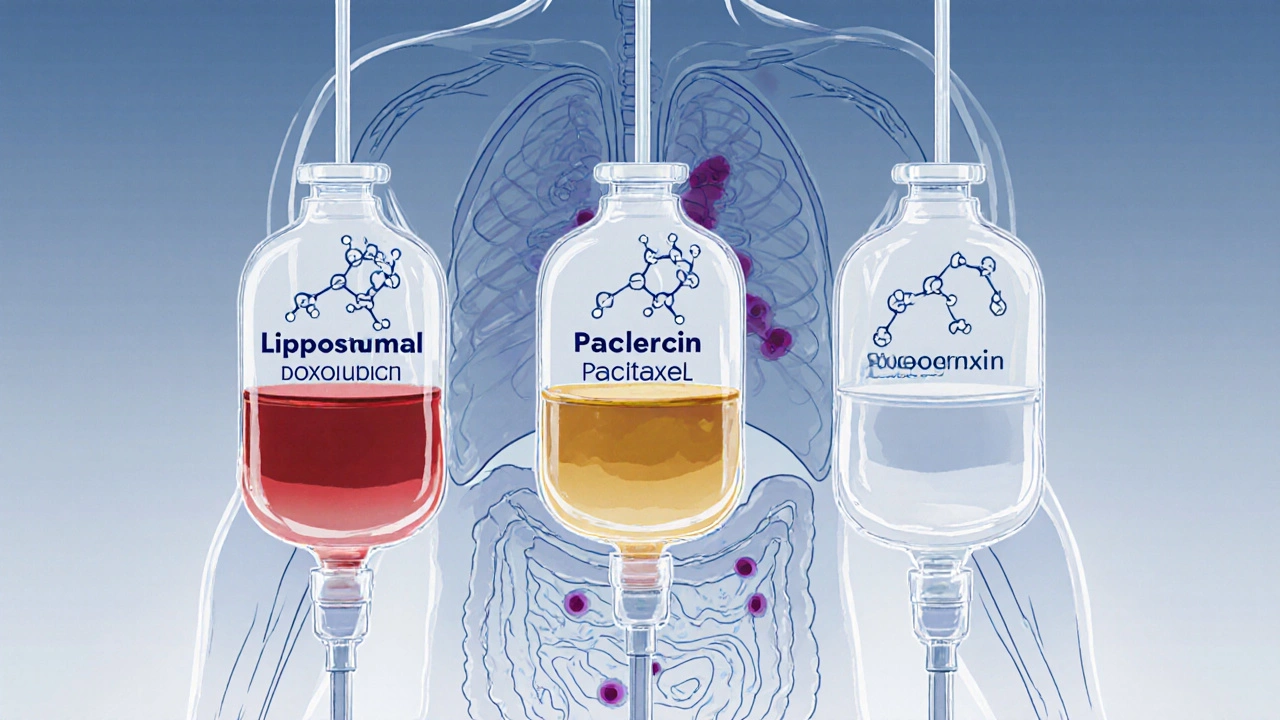Kaposi Sarcoma Chemotherapy Decision Helper
Patient Information
Treatment Recommendation
Kaposi sarcoma chemotherapy is often the missing piece that turns a stubborn skin lesion into a manageable condition. If you’ve been told you have Kaposi sarcoma (KS) and wonder why doctors are talking about chemo, this guide breaks down when, how, and what to expect from chemotherapy in modern KS care.
Quick Takeaways
- KS is driven by HHV‑8 infection and worsened by immune suppression, especially in people living with HIV.
- Chemotherapy is reserved for rapidly progressing disease, visceral involvement, or painful lesions.
- First‑line agents include liposomal doxorubicin and paclitaxel; each has distinct toxicity profiles.
- Effective KS treatment hinges on combining chemo with antiretroviral therapy (ART) to restore immunity.
- Side‑effect management-growth‑factor support, infection prophylaxis, and dose adjustments-keeps patients on therapy longer.
What Is Kaposi Sarcoma?
Kaposi sarcoma is a vascular tumor caused by human herpesvirus‑8 (HHV‑8) infection. It commonly appears as purple‑red plaques on the skin, but it can also involve mucous membranes, lungs, and the gastrointestinal tract. In the era of modern antiretroviral therapy, KS is most frequently seen in people living with HIV (PLWH) whose immune systems are compromised, though classic KS still occurs in older, immunocompetent men of Mediterranean or Eastern European descent.
Why Turn to Chemotherapy?
When KS lesions stay limited to the skin and the patient’s CD4 count is rising on ART, observation or local therapies (cryotherapy, laser) may suffice. However, chemotherapy becomes crucial when:
- Lesions spread quickly or become ulcerated.
- Visceral organs are involved, causing cough, bleeding, or abdominal pain.
- Painful nodules impair daily activities.
- Immune reconstitution after starting ART triggers an inflammatory flare (IRIS) that worsens KS.
In these scenarios, systemic chemo reduces tumor burden, relieves symptoms, and buys time for the immune system to recover.

Common Chemotherapy Regimens for KS
| Agent | Typical Dose | Response Rate | Main Toxicities |
|---|---|---|---|
| Liposomal doxorubicin a pegylated formulation that targets tumor vasculature | 20mg/m² IV every 3weeks | ≈70% overall response | Palmar‑plantar erythema, mild myelosuppression |
| Paclitaxel a taxane that stabilizes microtubules | 100mg/m² IV weekly (3weeks on, 1week off) | ≈80% response in refractory disease | Peripheral neuropathy, neutropenia |
| Bleomycin an antitumor antibiotic used in low‑dose regimens | 15IU IV weekly | ≈45% response | Pulmonary fibrosis risk (dose‑dependent) |
Choosing the Right Drug
Most clinicians start with liposomal doxorubicin because it balances efficacy with a tolerable side‑effect profile. If a patient has cardiac concerns, the pegylated form spares the heart better than conventional doxorubicin. When disease progresses despite doxorubicin, or when patients cannot tolerate its skin toxicity, paclitaxel becomes the go‑to second line.
Bleomycin is now rarely used as monotherapy because its response rate lags behind the other two agents, and the risk of lung injury rises with cumulative dosing. However, in low‑resource settings where access to liposomal formulations is limited, weekly bleomycin can still offer modest control.
Integrating Chemotherapy with HIV Care
Antiretroviral therapy (ART) is the backbone of KS management. Starting ART before or alongside chemo helps restore CD4 counts, which in turn improves long‑term KS control. Some key points:
- If the patient is ART‑naïve, begin a standard three‑drug regimen (e.g., tenofovir, emtricitabine, dolutegravir) as soon as possible.
- Monitor for drug‑drug interactions; protease inhibitors can increase paclitaxel levels, so dose adjustments may be needed.
- Watch for IRIS: a sudden flare of KS lesions can occur as the immune system revives. Short‑course corticosteroids can blunt the flare while chemo continues.
Effective KS treatment is a dance between suppressing viral replication, boosting immunity, and directly attacking tumor cells with chemo.

Managing Chemotherapy Side Effects
Patients often fear chemo more than the tumor itself. Here are practical steps that reduce interruptions:
- Growth‑factor support: Administering filgrastim or pegfilgrastim after each cycle lowers neutropenia risk, especially with paclitaxel.
- Skin care: For liposomal doxorubicin‑induced hand‑foot syndrome, recommend urea‑based moisturizers, cool compresses, and avoiding tight footwear.
- Neuropathy monitoring: Conduct baseline nerve exams before paclitaxel; if grade2 symptoms appear, reduce the dose by 20%.
- Hydration & renal protection: Adequate IV fluids before and after bleomycin lessen pulmonary toxicity.
- Emetic prophylaxis: Use a 5‑HT₃ antagonist (e.g., ondansetron) for any regimen that includes doxorubicin.
Open communication-asking patients about numbness, mouth sores, or unusual fatigue-helps catch problems early and keeps the treatment plan on track.
When to Look Beyond Chemotherapy
Not every KS case needs systemic chemo. Consider alternatives when:
- Lesions are limited to a few skin patches that can be treated with cryotherapy, intralesional vincristine, or laser ablation.
- The patient has severe cardiac dysfunction that precludes doxorubicin.
- Clinical trials offer novel agents such as immune checkpoint inhibitors (e.g., pembrolizumab) for refractory KS.
- Radiation therapy can rapidly palliate painful nodules on the lower extremities.
Always discuss the goals of care-whether the aim is cure, symptom control, or prolongation of life-before jumping into a new regimen.
Key Takeaways for Patients and Clinicians
- Start ART promptly; it works hand‑in‑hand with chemotherapy.
- Choose liposomal doxorubicin first; switch to paclitaxel if disease progresses or toxicity limits use.
- Proactively manage side effects-growth factors, skin care, neuropathy checks.
- Monitor CD4 counts and viral load; rising immunity often sustains KS remission after chemo stops.
- Consider clinical trials for refractory disease; they may provide access to cutting‑edge therapies.
Frequently Asked Questions
Is chemotherapy curative for Kaposi sarcoma?
Chemotherapy rarely cures KS on its own, but it can induce long‑lasting remission, especially when combined with effective ART that restores immune function.
How long does a typical chemotherapy course last?
Most regimens run for 6-9 cycles, roughly 3-6 months, until lesions shrink by at least 50% or imaging shows no active visceral disease.
Can I receive chemotherapy if I have a low CD4 count?
Yes, but the team will monitor infections closely, use prophylactic antibiotics if needed, and may start with lower doses until the immune system improves.
What are the signs that chemotherapy is working?
Patients typically notice fewer new lesions, existing nodules shrink or flatten, and any pain or bleeding subsides. Imaging of lungs or abdomen can confirm reduced visceral involvement.
Are there any lifestyle steps that help during treatment?
Maintaining good nutrition, staying hydrated, avoiding tobacco, and getting adequate rest boost overall tolerance. Regular dental checks help prevent mouth sores when chemotherapy lowers white blood cells.


Jessica Simpson
October 6, 2025 AT 15:28Wow, this guide really breaks down the chemo options for KS in a way that even my grandma could follow. I love how it points out that liposomal doxorubicin is usually the first pick because of its nicer side‑effect profile. The bit about starting ART early is crucial – the immune system basically does the heavy lifting once it’s back online. Also, the table with doses and response rates is gold for anyone trying to understand what to expect. Definitely sharing this with my support group!
Ryan Smith
October 7, 2025 AT 05:21Sure, because the pharma giants are totally not pushing chemo just to make a profit. 🙄
John Carruth
October 7, 2025 AT 19:15Alright folks, let me walk you through why chemotherapy still matters in the era of potent antiretrovirals. First, Kaposi sarcoma is a vascular tumor driven by HHV‑8, and while ART can restore immunity, the virus can still seed lesions faster than the immune system can clear them. Second, when lesions become rapidly progressive, ulcerated, or involve internal organs, the tumor burden can cause life‑threatening complications that ART alone won’t fix. Third, systemic chemo like liposomal doxorubicin targets the tumor’s blood supply, leading to rapid shrinkage of both cutaneous and visceral lesions – often within a few cycles. Fourth, in patients with low CD4 counts, waiting for immune reconstitution can be dangerous because opportunistic infections may take advantage of the compromised barrier the tumors create. Fifth, chemo can act as a bridge: it lowers tumor load while ART ramps up, reducing the risk of IRIS flares that could otherwise worsen the disease. Sixth, the side‑effect profile of liposomal doxorubicin is relatively mild compared with traditional anthracyclines, making it a reasonable first‑line choice for most patients. Seventh, Paclitaxel steps in when doxorubicin fails or isn’t tolerated, offering an even higher response rate in refractory cases, albeit with neuropathy concerns that need monitoring. Eighth, for those with cardiac issues, the pegylated formulation spares the heart, which is a key consideration in older patients. Ninth, supportive care – growth‑factor support, skin‑care regimens, and anti‑emetics – are essential to keep patients on schedule and avoid dose reductions. Tenth, prophylactic antibiotics and antifungals become necessary when neutropenia is profound, especially in the setting of low CD4 counts. Eleventh, regular imaging and lesion measurements help gauge response and decide when to stop therapy, typically after 6‑9 cycles or once a 50 % reduction is achieved. Twelfth, integrating chemo with ART requires attention to drug‑drug interactions; for instance, protease inhibitors can increase paclitaxel levels, so dose adjustments may be needed. Thirteenth, patient education on signs of infection, neuropathy, and hand‑foot syndrome empowers them to report issues early. Fourteenth, the ultimate goal is not just remission of lesions but also restoration of quality of life, allowing patients to return to work and daily activities. Fifteenth, for those who can’t access liposomal formulations, low‑dose bleomycin remains a cost‑effective, albeit less potent, alternative. Lastly, always discuss goals of care – whether the aim is curative, palliative, or symptom‑focused – before committing to a full chemo regimen. In short, chemo is a vital component of comprehensive KS management, especially when disease is aggressive or immune recovery lags behind.
Melodi Young
October 8, 2025 AT 09:08Nice rundown, but don’t forget that sometimes just a good cryotherapy session can zap those pesky skin spots without all the chemo drama.
Tanna Dunlap
October 8, 2025 AT 23:01Honestly, the moral side of pushing chemo on patients with already compromised immunity is a bit unsettling. We should always weigh the risk of further suppressing the bone marrow against the potential benefit, especially when the disease isn’t immediately life‑threatening.
Troy Freund
October 9, 2025 AT 12:55True, but think of it this way: chemo is just a tool in the toolbox. If we use it wisely and pair it with ART, we give patients a real chance at a better life. Balance is key.
Mauricio Banvard
October 10, 2025 AT 02:48Listen, the pharmaceutical lobby is definitely involved here – they love to market doxorubicin as the miracle drug while ignoring cheaper alternatives like bleomycin that can still do the job in low‑resource settings.
Paul Hughes
October 10, 2025 AT 16:41Appreciate the caution, but let’s not discount the real data showing >70 % response rates with liposomal doxorubicin. It’s not just hype; it’s backed by multiple trials. 😊
Mary Latham
October 11, 2025 AT 06:35Chemo works.
Marie Green
October 11, 2025 AT 20:28It’s really tough for patients who have to juggle chemo side effects and the stigma of HIV at the same time. Compassionate care makes a huge difference.
TOM PAUL
October 12, 2025 AT 10:21Absolutely, and adding a little optimism can go a long way. Encouraging patients about the high response rates while being realistic about side‑effects helps keep morale up.
Ash Charles
October 13, 2025 AT 00:15Look, if you’re not going to give the patient the strongest possible regimen right away, you’re basically delaying their recovery. Push the chemo, adjust doses as needed, and monitor – there’s no room for half‑measures.
Michael GOUFIER
October 13, 2025 AT 14:08While I respect your enthusiasm, it is prudent to emphasize individualized treatment planning. The selection of regimen should consider cardiac function, prior toxicities, and drug‑drug interactions with ART to optimize safety.
michael Mc Laughlin
October 14, 2025 AT 04:01Great info! Keep it simple and encouraging – people need hope, not a lecture.
Luke Schoknceht
October 14, 2025 AT 17:55Let’s get real for a second – this whole “balanced approach” narrative is a convenient façade for the medical establishment to shirk responsibility. They plaster shiny success rates on glossy papers while ignoring the brutal reality that a substantial fraction of patients still endure crippling neuropathy, relentless hand‑foot syndrome, and endless cycles of infection because their CD4 counts stay pitifully low. The so‑called “supportive care” is often an afterthought, relegated to a footnote, and the patient is left scrambling for growth factors they can’t afford. Moreover, the emphasis on ART adherence is a thinly veiled reminder that the onus is on the patient to fix a problem that the system helped create by delaying access to life‑saving chemo. In short, the narrative sanitizes a messy, under‑funded, and sometimes downright dangerous treatment landscape. It’s high time we call out these half‑truths and demand transparent, patient‑centered protocols that prioritize safety over statistics.
mauricio gonzalez martinez
October 15, 2025 AT 07:48Just a quick note: the decision helper could use a clearer visual cue for the “visceral” option.
Christian Freeman
October 15, 2025 AT 21:41I concur. A distinct icon would aid quick identification for clinicians under time pressure.
julie shayla
October 16, 2025 AT 11:35Oh great, another one‑size‑fits‑all chemo playbook. Because what patients really need is another protocol to memorize, not personalized care. If you’re going to prescribe a drug, at least acknowledge the humanity behind the chart.
Super Mom
October 17, 2025 AT 01:28Thanks for pointing that out – I’ll make sure to tailor the approach for each individual, focusing on both the medical and personal aspects of their journey.